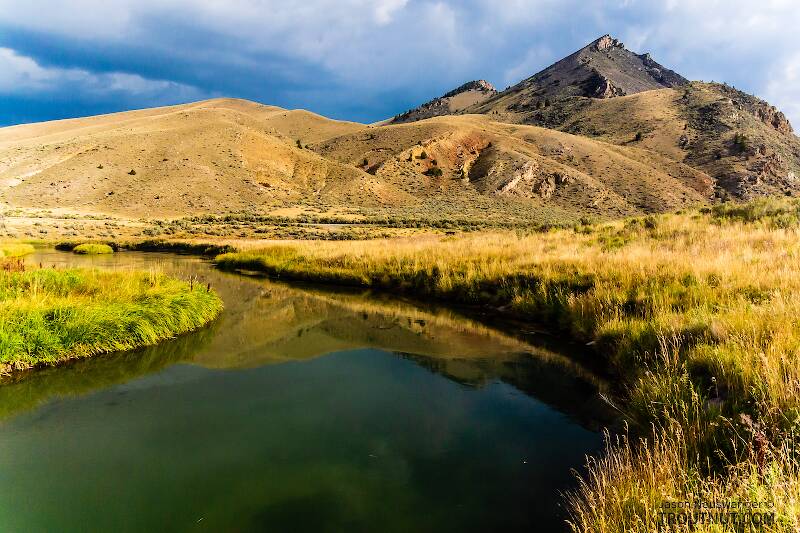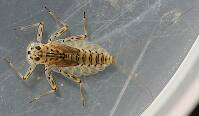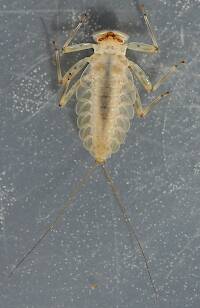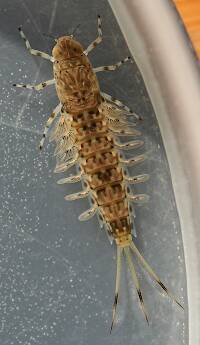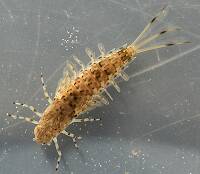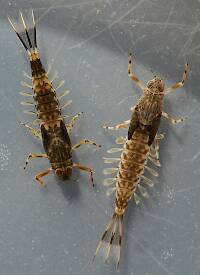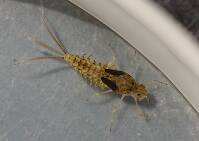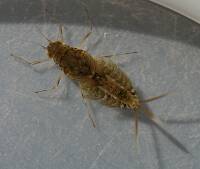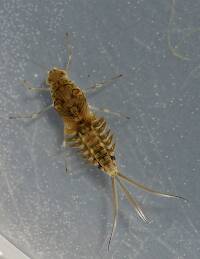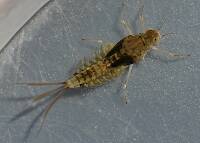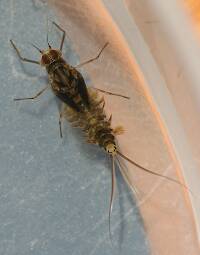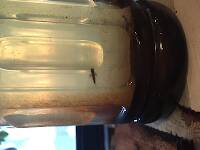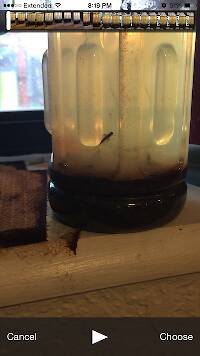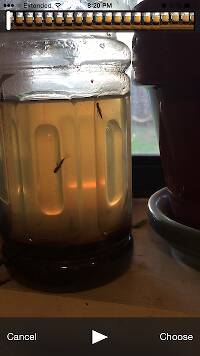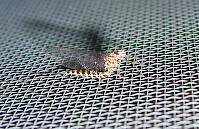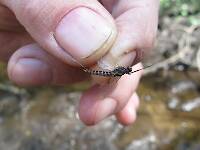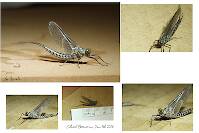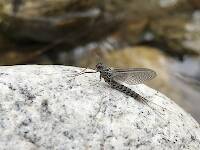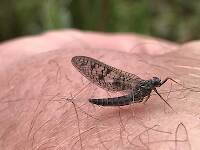
Blue-winged Olives
Baetis
Tiny Baetis mayflies are perhaps the most commonly encountered and imitated by anglers on all American trout streams due to their great abundance, widespread distribution, and trout-friendly emergence habits.
Featured on the forum
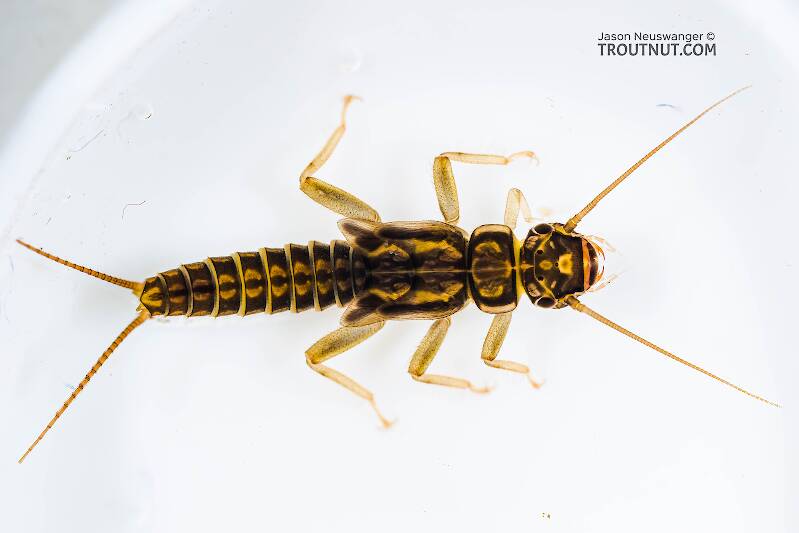

Troutnut is a project started in 2003 by salmonid ecologist Jason "Troutnut" Neuswanger to help anglers and
fly tyers unabashedly embrace the entomological side of the sport. Learn more about Troutnut or
support the project for an enhanced experience here.
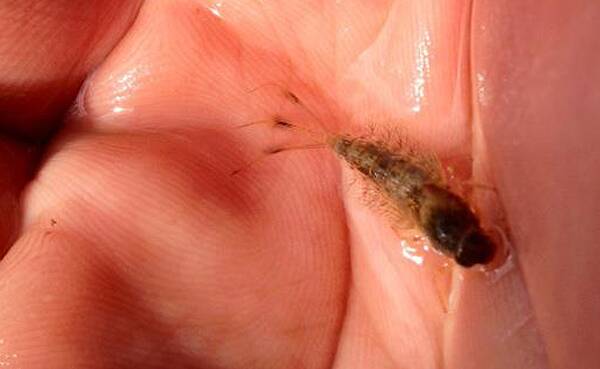
JOHNW on May 12, 2012May 12th, 2012, 3:04 am EDT
Need help with ID of this nymph. I know picture is not the best quality.
Behavioral note this fellow was a very strong swimmer.
JW
Behavioral note this fellow was a very strong swimmer.
JW
"old habits are hard to kill once you have gray in your beard" -Old Red Barn
Wiflyfisher on May 12, 2012May 12th, 2012, 8:32 am EDT
Looks sort of like a Siphloplecton or Isonychia nymph too me.
John S.
https://WiFlyFisher.com
https://WiFlyFisher.com
Entoman on May 12, 2012May 12th, 2012, 9:58 am EDT
Hi John & John,
I agree about the possibility of the first suggestion. It looks like it could be Siphloplecton basale (Pseudo Gray Drake). Isonychia nymphs aren't marked like this, shaped like this, and their gills aren't so prominently tracheated. Also, the forelegs are more prominent and hairy.
Was the underside pale with a thin dark stripe running down the center?
I agree about the possibility of the first suggestion. It looks like it could be Siphloplecton basale (Pseudo Gray Drake). Isonychia nymphs aren't marked like this, shaped like this, and their gills aren't so prominently tracheated. Also, the forelegs are more prominent and hairy.
Was the underside pale with a thin dark stripe running down the center?
"It's not that I find fishing so important, it's just that I find all other endeavors of Man equally unimportant... And not nearly as much fun!" Robert Traver, Anatomy of a Fisherman
PaulRoberts on May 12, 2012May 12th, 2012, 10:49 am EDT
Looks a bit like Siphlonurus, but Siphloplecton will have forked claws where the former has a single claw.
Entoman on May 12, 2012May 12th, 2012, 12:12 pm EDT
Paul,
Yes, and frankly more than a bit.:) Siphlonurus is certainly another possibility and they are far more common. They can also have noticeable gill tracheation but they (gills) are shaped entirely different than Siphloplecton (heart shaped, much wider at the apex and doubled up) at least on the first few segments. The margins of siphlonurid gills are clearly noticeable with some cloudiness to the membranes, whereas Siphloplecton's are so transparent that in the right lighting they look just like old dead branches waving in the water. The gills in this photo certainly look to be denser in the first couple of segments, signaling Siphlonurus. Like the claws though, they can't really be made out. The heavy tracheation and lack of sclerotized band on the gill margins definitely rules out the similar looking ameletids, so it's between these two...
Looking directly down, Siphlonurus usually has tails approaching abdominal length with the abdomen comprising a little more than two thirds total body length. Siphloplecton on the other hand, will have tails substantially shorter then abdomen length and the abdomen will take up as much as 3/4 total body length. The angle of the photo coupled with the fore lengthening affect of the body parts closest to the lens makes it difficult to tell. It's hard to describe, but the two have distinctly different silhouettes. Here are two examples that John can use to perhaps jog his memory.
Siphloplecton
http://flyfishingentomology.com/forum/Replies_Display.php?t=0049
Siphlonurus
http://www.troutnut.com/specimen/997
Looks a bit like Siphlonurus...
Yes, and frankly more than a bit.:) Siphlonurus is certainly another possibility and they are far more common. They can also have noticeable gill tracheation but they (gills) are shaped entirely different than Siphloplecton (heart shaped, much wider at the apex and doubled up) at least on the first few segments. The margins of siphlonurid gills are clearly noticeable with some cloudiness to the membranes, whereas Siphloplecton's are so transparent that in the right lighting they look just like old dead branches waving in the water. The gills in this photo certainly look to be denser in the first couple of segments, signaling Siphlonurus. Like the claws though, they can't really be made out. The heavy tracheation and lack of sclerotized band on the gill margins definitely rules out the similar looking ameletids, so it's between these two...
Looking directly down, Siphlonurus usually has tails approaching abdominal length with the abdomen comprising a little more than two thirds total body length. Siphloplecton on the other hand, will have tails substantially shorter then abdomen length and the abdomen will take up as much as 3/4 total body length. The angle of the photo coupled with the fore lengthening affect of the body parts closest to the lens makes it difficult to tell. It's hard to describe, but the two have distinctly different silhouettes. Here are two examples that John can use to perhaps jog his memory.
Siphloplecton
http://flyfishingentomology.com/forum/Replies_Display.php?t=0049
Siphlonurus
http://www.troutnut.com/specimen/997
"It's not that I find fishing so important, it's just that I find all other endeavors of Man equally unimportant... And not nearly as much fun!" Robert Traver, Anatomy of a Fisherman
Crepuscular on May 12, 2012May 12th, 2012, 5:55 pm EDT
John, where did you collect it? Clark's creek perhaps?
Entoman on May 12, 2012May 12th, 2012, 9:23 pm EDT
Eric -
I was hoping you'd chime in. What do you think? No fair waiting for John's response to all the goings on... You're a local for Pete's sake! :)
I was hoping you'd chime in. What do you think? No fair waiting for John's response to all the goings on... You're a local for Pete's sake! :)
"It's not that I find fishing so important, it's just that I find all other endeavors of Man equally unimportant... And not nearly as much fun!" Robert Traver, Anatomy of a Fisherman
JOHNW on May 13, 2012May 13th, 2012, 9:14 am EDT
Unfortunatly I did not collect the sample nor did I ever see it beyond the picture posted above. This was collected by a friend of mine who is doing some work on a very small limestone influenced stream on his property.
Eric this stream is about 75-80 miles SW of Clarks and the particular run this guy was harvested in typically goes dry in the summer (actually a runoff trib to the stream he is working on). I have an invite to come back and fish the larger branch this week so we may need to try and capture another for further photographic studies.
My gut reaction was that it was an iso based on how strongly it swam in the video my buddy took but then the distinct lack of the dorsal stripe and coloration differences caused me to doubt that hence my post here. Let me also add that my typical ID process goes something like Spences' Little yellow bug system so counting gill truncations or describing their shape is beyond me.
JW
Eric this stream is about 75-80 miles SW of Clarks and the particular run this guy was harvested in typically goes dry in the summer (actually a runoff trib to the stream he is working on). I have an invite to come back and fish the larger branch this week so we may need to try and capture another for further photographic studies.
My gut reaction was that it was an iso based on how strongly it swam in the video my buddy took but then the distinct lack of the dorsal stripe and coloration differences caused me to doubt that hence my post here. Let me also add that my typical ID process goes something like Spences' Little yellow bug system so counting gill truncations or describing their shape is beyond me.
JW
"old habits are hard to kill once you have gray in your beard" -Old Red Barn
Entoman on May 13, 2012May 13th, 2012, 12:17 pm EDT
John,
Based on your description of the habitat, I think Paul's suggestion of Siphlonurus (Gray Drake) is closer to the mark, especially if Eric agrees. I don't know much about metretopodid life history but I do know that siphlonurids love to migrate out of main stems to hatch; even flooded bogs or the merest trickles that dry up in the Summer.
Based on your description of the habitat, I think Paul's suggestion of Siphlonurus (Gray Drake) is closer to the mark, especially if Eric agrees. I don't know much about metretopodid life history but I do know that siphlonurids love to migrate out of main stems to hatch; even flooded bogs or the merest trickles that dry up in the Summer.
"It's not that I find fishing so important, it's just that I find all other endeavors of Man equally unimportant... And not nearly as much fun!" Robert Traver, Anatomy of a Fisherman
Konchu on May 13, 2012May 13th, 2012, 12:59 pm EDT
been watching to see how this would play out; i've been suspecting Siphlonurus, and the habitat is right
Crepuscular on May 13, 2012May 13th, 2012, 1:34 pm EDT
I think you guys pretty much covered it all without me! Now that I know the habitat,I'd call it Siphlonurus too. Pretty brave of me I know :)... The only place I know of in my area that has a fairly good population of Siphloplecton basale is Clarks creek, which is why I was trying to find out if it came from there. I thought it looked a little "stout" to be Siphloplecton but the angle was weird.
Entoman on May 13, 2012May 13th, 2012, 2:42 pm EDT
Well there you go, John. Pretty good consensus built on Siphlonurus.
Sorry John (WIflyfisher)... I tried to keep you in the game, but no cigar. :)
Sorry John (WIflyfisher)... I tried to keep you in the game, but no cigar. :)
"It's not that I find fishing so important, it's just that I find all other endeavors of Man equally unimportant... And not nearly as much fun!" Robert Traver, Anatomy of a Fisherman
Quick Reply
Related Discussions
Topic
Replies
Last Reply
6
Jun 4, 2016
by Creno
by Creno
9
Aug 11, 2011
by Goose
by Goose
6
Jun 20, 2008
by GONZO
by GONZO
4
Jun 17, 2020
by Leskorcala
by Leskorcala

